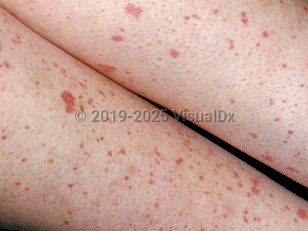Immune thrombocytopenic purpura in Child
Alerts and Notices
Important News & Links
Synopsis

While the pathophysiology of ITP is incompletely understood, it is generally thought that ITP patients have circulating antibodies that react with platelet surface antigens consequently causing platelet destruction, primarily in the reticuloendothelial system of the spleen. ITP onset can be triggered by various viral infections (HIV, cytomegalovirus [CMV], hepatitis C virus [HCV], varicella zoster virus [VZV], autoimmune diseases, and lymphoproliferative disorders). Acute ITP in children may follow a viral infection or upper respiratory tract infection and is the most common trigger in pediatric patients, accounting for more than 90% of cases. Seasonal fluctuations in ITP diagnosis have been reported, likely due to viral infection as potential disease triggers. It is important to exclude secondary causes of thrombocytopenia, which have similar clinical presentations as ITP but significantly different management strategies.
Signs and symptoms of ITP vary according to the patient platelet levels. Patients with platelet counts between 30 000 and 50 000 usually present with easy bruising. Patients with platelet counts between 10 000 and 20 000 can have significant petechiae, purpura, or ecchymoses on the skin and mucosal surfaces. Prominent oral mucosal lesions may occur. Severe bleeding complications including intracranial hemorrhage, gastrointestinal bleeding, and severe menorrhagia are rare, due to the intact coagulation cascade, but can occur in ITP patients with severely low platelet counts.
Children with ITP present with mucosal bleeding from the gums and nostrils and petechiae and purpura on the extremities that is not linked to a history of trauma. Blood in the urine or stool may be present. Fatal hemorrhage, although rare, is a serious potential complication, with the most significant being intracranial hemorrhage, which presents with neurological symptoms like headache, altered mental status, ataxia, and blurred vision.
Although ITP patients can present with very low platelet counts, most pediatric patients (greater than 80%) have mild clinical symptoms and rarely serious bleeding. Recovery is usually spontaneous and occurs completely within a few days to weeks, in most cases. Approximately 10%-20% of children who present with ITP develop chronic ITP, lasting more than 6 months. There are currently no reliable metrics to predict which patients will progress to the chronic form. However, over 50% of children still have the possibility of spontaneous remission, even after years of chronic ITP.
Codes
D69.3 – Immune thrombocytopenic purpura
SNOMEDCT:
2897005 – Immune thrombocytopenia
Look For
Subscription Required
Diagnostic Pearls
Subscription Required
Differential Diagnosis & Pitfalls

Subscription Required
Best Tests
Subscription Required
Management Pearls
Subscription Required
Therapy
Subscription Required
Drug Reaction Data
Subscription Required
References
Subscription Required

